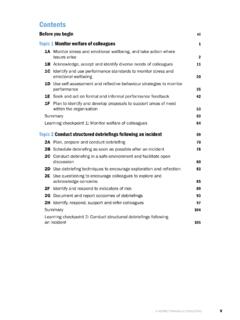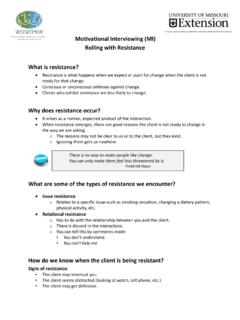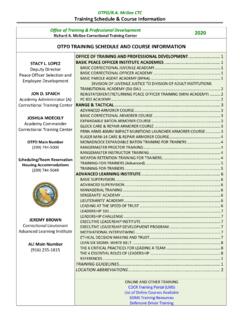Transcription of A pocket guide to Motivational Interviewing
1 A pocket guide to Motivational InterviewingDeveloping competency in Motivational Interviewing (MI) takes practice. The best way to learn MI is with practice with feedback. This tool will not replace that! Have someone competent in MI observe a session (or recorded session with permission) and give you feedback on their this guide will do is help you after training plan and review sessions using is Motivational Interviewing ? Motivational Interviewing is a collaborative, goal orientated style of communication with particular attention to the language of change. It is designed to strengthen personal motivation for and commitment to a specific goal by eliciting and exploring the person s own reasons for change within an atmosphere of acceptance and compassion.
2 (Miller and Rollnick 2013)The essence of MI is that it is the client rather than the worker who makes the argument for change. It is not a collection of techniques but a way to guide conversation to activate a person s own motivation and resources for change. The way in which you talk with people can substantially influence their personal motivation for behaviour roots and a strong trunk helps produce fruit you are working toward OARS Listen till you understand strategiesProcessesPrinciplesSpiritThe Spirit of MIPartnershipAcceptanceCompassionEvoking Principles (RULE)Avoid the righting reflexUnderstandListen EmpowerThere is something in human nature that resists being coerced and told what to do.
3 Ironically, it is acknowledging their freedom to choose and not change that sometimes makes change will you do to stay consistent with the spirit and principals of MI?The core skills of MIO: Open questions: to explore concerns, promote collaboration, and understand the client s perspective. A: Affirmations: to support strengths, convey : Reflective listening: to explore deeper, convey understanding, deflect discord, elicit change : Summarise: to organise discussion, clarify motivation, provide contrast, focus the session and highlight change with each question if possible:-Encouraging the other person to elaborate, amplify, confirm, or correct. A Simple Reflection may use different words but stays at the same meaning A complex reflection makes a guess about what the person means.
4 It adds something that deepens understanding and encourages further variety in your reflections:-Sounds What I m hearing you re saying re feeling you, it s a matter your point of view,..You would imagine your eyes,..Your belief is concern is seems to you re not terribly excited re not much concerned thing that bothers you important thing as you see it can get as much from reflections, even more than relying on clients will teach you how effective your reflections are. They keep processes of MIEngaging Allow time to develop a trusting relationship Listen, understand, Avoid traps - How comfortable is this person in talking to me? - Do I understand this person s perspective/ concerns? Focusing Help client to prioritise areas of change.
5 - An agenda map helps support focusing. - What goals for change does this person really have? - Do I have a clear sense of where we are going? - Do I have different aspirations for change for this person? - Does this feel more like dancing or wrestling? - Does it feel like we are moving together, not in different directions?EngagingFocusingEvokingPlanni ngEvoking Elicit the person s own reasons for change. - Explore readiness, willingness and ability to change. - Am I steering too far or too fast in a particular direction? - Is any reluctance more about confidence or importance of change? - Elicit and respond to change If ready help the person establish a change plan - What would be a reasonable next step toward change?
6 - Am I remembering to evoke rather than prescribe a plan? - Am I offering needed information or advice with permission?Some tools in A Nudge in the Right Direction may be (4).pdf What processes did your session focus on?Traps to avoidWhen working with people in a helping capacity it is easy to fall into certain traps that are less helpful. The assessment trap - bombarding the person with questions The expert trap - communicating I have all the answers The premature focus trap - talking about change too early The labelling trap - calling a problem by name The blaming trap The chat trap. Change talkChange talk is the client making statements that are in favour of change. Forms of change talk - DARN Change Talk (Darn)D = Desire indicating a desire to make a = Ability statements.
7 The client s self-efficacy or belief in their ability to make changes. R = Reasons statements. Statements that reflect the reasons the client gives for considering a change. I have to quit smoking because of my asthma. N = Need statements. Statements that indicate a need for change. The emphasis is more emotional rather than a more cognitive MI HillPreparatory change talkMobilising change talk(pre)contemplationpreparationactionM obilizing Change Talk (CAT)C = Commitment. Statements that are linchpins in the change talk and critical predictors of change occurring. I am going I intend I will .. A = Activation. This indicates movement toward action, yet hasn t been done. I m ready I am prepared to .T = Taking steps. This indicates that the person has already begun change talk - Your goal is to strengthen change talk and/or commitment a typical dayAsking evocative questions Using the importance rulerQuerying extremesLooking backLooking forwardExploring goals and valuesUsing scaling questions in an MI Style 1.
8 On a scale of 0 - 10, 0 being not important at all, and 10 most important, what number would you pick for yourself as to where you are with importance on this change?2. Why are you at a ____, and not a zero?3. What are the 3 main reasons you want to make this change?4. What ideas do you have about making these changes?5. What would it take to get you from That Number to One Number Higher6. What will you do next?Responding to change talk When you hear change talk, respond Elaboration or details, In what ways? How are you going to do that? Ask for specific examples Affirm change talk through reinforcement, encouragement Reflect what the person is saying Summarise. It is like collecting flowers into a bouquet. (only pick the fresh ones).Responding to sustain talk and discordSustain talk is about the behaviourDiscord is about your relationship with the client Reflective responses to sustain talk Straight reflection Amplified reflections Double sided responses Emphasising autonomy Reframing Agreeing with a twist Listening to the cons of change Coming along discord Defending Squaring off Interrupting to discord Apologising Shifting Confidence Evoke confidence talk Confidence ruler Give information and advice (with permission)
9 Identify and affirm strengths Review past success Brainstorm ways to change Reframing Hypothetical exchange informationAlways ask permissions to given information Use Elicit-Provide-ElicitElicit they want it/ are ready for it, provide it neutrally, elicit again. (Ask / provided / ask)Ask: What do they already : Seek permission to add to current understanding, correct misinformation using what research tells us or what others have found : Follow-up: How does what I told you fit into your thinking/situation? Sit back and they ready: signs of readiness Decreased ambivalence Decreased discussion about the problem Resolve. The client appears to have reached some resolution Change talk. You are hearing more DARN-CAT statements Questions about change.
10 Clients may begin to ask what they could do about the problem, how other people do it Envisioning. The client may talk about how life might be after a change. They look ahead and can see difficulties or positives if a change were made Experimenting. The client may have begun experimenting with change since the last session. What do I do now?Move to planning. If you have misjudged readiness the person will let you know. Remember our clients will teach us MI!Reviewing a session - how did I do? Did it feel like I was wrestling or dancing? Did I seek to understand this person and their world? What was my ratio of questions versus reflections like? Did I reassure this person that ambivalence to change is normal? Did I encourage this person to talk about his/her reasons for not changing?






